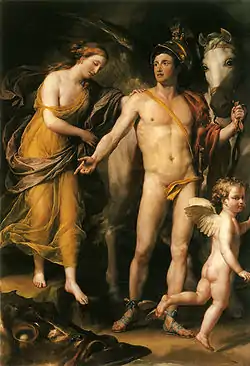Westmorland (ship)
The Westmorland or Westmoreland[1] was a 26-gun British privateer frigate, operating in the Mediterranean Sea against French shipping in retaliation for France's opposition to Great Britain in the American Revolutionary War.
 | |
| History | |
|---|---|
| Name: | Westmorland |
| Captured: | By French (1779); later recaptured |
| General characteristics | |
| Sail plan: | Full-rigged ship |
| Armament: | 26 guns |
Service history
The most notable incident in the life of the Westmorland occurred shortly after she sailed for Britain from Livorno under Captain Michael Wallace late in 1778, carrying a large monetary payment for her inbound cargo of salt cod from Newfoundland (Livorno was a trade hub for this commodity), food goods,[2] and 57 crates of artistic objects collected by Grand Tourists such as the Duke of Gloucester, Sir John Henderson and the Duke of Norfolk.[3]
In January 1779,[4] she was given chase by four French ships, comprising two men-of-war, the Caton (64) and the Destin (74), and two smaller vessels. Wallace attempted to outsail them but, outgunned as he was, soon felt he had little option but to allow the French to board his ship. She was then allowed by Spain (then friendly with France though not yet — in formal terms at least — at war with Britain) to continue to Málaga.

At Málaga her artistic contents were passed on from the French government to two trading companies with links to Ireland, despite Wallace's protests that the ship was full of "extremely precious goods" (the French had already seized her cash cargo), and the Spanish king was informed by his prime minister, the Count of Floridablanca, of the arrival of the art works. Upon Spain's formal declaration of war, king Charles III secretly bought the art from a syndicate of Madrid merchants for 360,000 silver reales (a discount on their original asking price of 600,000 gold doubloons, but still a considerable sum) and had it brought by cart to the capital. The portraits of Basset and Lord Lewisham, meanwhile, were acquired by the Spanish Prime Minister.
Although the British consul at Cadiz had initially informed the British Admiralty that the Westmorland and her cargo had been seized as legitimate prizes, demands followed from the British ambassador, firmly backed at cabinet level, for the repatriation of the art and (in a prisoner exchange for French and Spanish prisoners taken by the Royal Navy) the crew of the Westmorland. Yet to this day, all these coveted artistic treasures remain the possession of the Prado Museum, the Real Academia, and other Spanish national collections. There were only a few, very limited exceptions: a package of Catholic relics intended for the Duke of Norfolk (which the Spanish returned unopened to the Vatican); and Sir Watkin Williams Wynn's Perseus and Andromeda by Mengs, which ended up in the collection of Catherine the Great at the Hermitage Museum.
In 1784, the £100,000 for which the art had been insured at Livorno were paid out in London. The Westmorland, for its part, was renamed, re-commissioned into the Spanish fleet, but eventually re-taken in the Caribbean by the British.
In 2012 an exhibition of many of the art works captured was held at the Ashmolean Museum at Oxford University and then traveled to the Yale Center for British Art in New Haven, United States.[5][6][7]
Notes
- Sometimes referred to as HMS Westmoreland/Westmorland. However, according to Ships of the Royal Navy, like most other privateers she was never actually commissioned into the Royal Navy.
- These included almost 4000 barrels of anchovies, 129 pounds of silk, 150 crates of manna and oil, thirty-four bales of hemp, thirty-two Parmesan cheeses, twenty-two barrels of Tartar salt and medicines and five crates of artificial flowers.
- Including Batoni's portrait of Charles Cecil Roberts and a second portrait called An English Gentleman; sculptures by Albacini and Christopher Hewetson; a marble chimney originally destined for the Duke of Gloucester; musical scores, violins, violin strings, hats (two barrels), ornamental fans, expensive books; Piranesi sketches; specimens of lava from Mount Vesuvius sent by William Hamilton; relics; paintings by Pompeo Batoni, Anton Raphael Mengs, Carlo Maratta, Guido Reni, and Guercino, among others; modern copies of Raphael's paintings; drawings by artists working in Rome, including John Robert Cozens; 23 crates of ancient Roman marble statues and fragments, plus modern plaster casts; other carved marble mantelpieces, slabs of coloured marble for table-tops, full-sized Piranesi-like "vasi candelabri", 84 rolls of deluxe blank Genoa paper, a crate of flowering onion bulbs and seeds; boxes of pomade, sweetmeats and citrus-blossom water, four barrels of Madeira, and a double-barreled rifle.
- Sánchez-Jáuregui and Wilcox. The English Prize: The Capture of the Westmorland, An Episode of the Grand Tour. New Haven, CT: Yale University Press, 2012.
- Higgins, Charlotte (21 November 2011). "Revealed: Grand Tour loot of the Presa Inglesa". The Guardian. Retrieved 21 November 2011.
- Vickery, Amanda (4 May 2012). "The captured cargo that unpacks the spirit of the grand tour". The Guardian. Retrieved 4 August 2017.
- Sánchez-Jáuregui and Wilcox. The English Prize.
References
- Sánchez-Jáuregui, Maria Dolores, and Wilcox, Scott. The English Prize: The Capture of the Westmorland, An Episode of the Grand Tour. New Haven, CT: Yale University Press, 2012. ISBN 978-0300176056.
- Sánchez-Jáuregui, Maria Dolores. "Two Portraits of Francis Basset by Pompeo Batoni in Madrid". The Burlington Magazine, Vol. 143, No. 1180 (Jul 2001), pp. 420–425.
- Trumble, Angus. "Pirates of the Mediterranean: Mining the Cargo of the Westmorland in Madrid". Trinity Today, December 2007, pp 14 to 15
- Tremlett, Giles. 'Spaniards looted British art hoard' The Times, 1999.